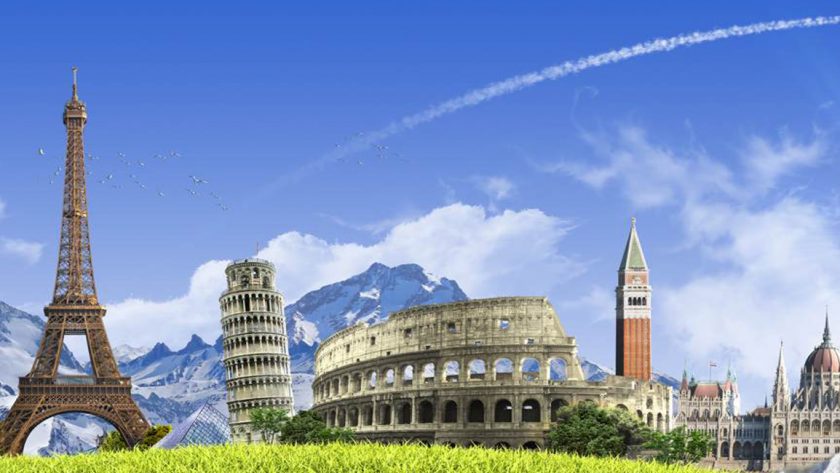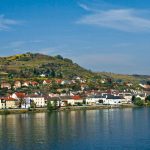When my muscles ache from hefting my backpack and my clothes might not be as clean as I would like, it feels good to relax in one spot for a while. But before long, that familiar itch returns (not from being dirty, but to get going), the backpack’s slung on my shoulder, and I’m glad to be on the move. I put a lot of stock in the mantra “It’s not the destination, but how you get there that matters,” and so myself and two other Student Traveler writers explored different ways of “getting there” all over Europe.
There are a surprising number of options for hopping around the Old Country. Budget airlines such as EasyJet will zip across Europe quickly and cheaply, but it’s not much of an experience. All the major (and most of the minor) towns can be reached by train and bus. Group tours such as Contiki will hit all the hot spots, allowing you to relax and enjoy the ride. At the other extreme, hitchhiking is a relatively common sight that maximizes both the thrill and frustration of travel. Get some freedom by renting a car, but deal with the insanity of parking in medieval alleys. Tour by bike and see the land without the barrier of a windshield between you and every church. Hike a trail and lose even the road. How do you want to get around Europe?
THE CLASSIC: EURAIL
The trains in Europe will get the intrepid traveler just about anywhere necessary. The Eurail system is justly known to American backpackers as a cheap, safe, efficient, and fun way to get around, and it’s how most Europeans travel themselves. Trains can be a great place to meet fellow travelers, or maybe an English-speaking local (simply search the seats for a young, student type.) On a train in northern Italy, I met a shoe designer and a genetics student. In Germany, I was invited to cycle for the weekend along the Austrian border. Of course, you run the risk of seven hours in a compartment with a drunk peasant, an angry nun, and an obnoxious American trustafarian pretending to be Hemingway on Dad’s dime.
There are a variety of Eurail passes available. If you’re under 26 years old, you can buy a Youth Eurail passes in the States. It’s a reasonably priced ($620 for a one-month pass) way to travel through 17 countries of Europe (UK excluded). Pass options include unlimited travel within a given time period. A cheaper option is the Flexipass, where you choose a number of travel days within a time period (for example, 15 travel days within a two-month period). For those over 26 years old, first-class passes can be purchased for about 50 percent more. Or consider the Europass if you’ll only be visiting France, Germany, Italy, Spain, and Switzerland. Practically any combination of countries and days can be combined to meet your general travel plan-if you have a plan! A national rail pass is an option if you expect to stay within one country only.
There are some downsides to Eurailing. Because you typically pay for a block of time, there is a pressure to always be on the move. When I was planning a hiking trip through the Bavarian Alps, some travelers I had met declined to join me because they didn’t want to waste possible train-riding days walking. If you don’t plan on being on the move constantly, it might make more sense to buy separate tickets or get the Flexipass. But don’t forget about the classic Eurail tip: the benefit of all-night train trips means there’s no need for a hostel! TS
THE GROUP THING: CONTIKI TOURS
Put a group of twenty-somethings on a bus touring Europe for two weeks and there will undoubtedly be some friendships forged, a little romance, a few disagreements, a lot of laughs, and a couple of downright obnoxious people; our Contiki tour (www.contiki.com) was no exception. Don’t expect to meet lots of local Europeans because your bus crew will be your new friends. But as in life, so it is on a tour, everything depends on your personality. Considering the amount of fun we had, the number of things we saw, and the really competitive price ($919, 14 day trip), I can’t think of any reason a student wouldn’t choose Contiki to explore Europe this summer. Sure, we are all about independent travel and exploration here at Student Traveler Magazine, but that’s just it you can have some of that on a Contiki tour too. We had a group of four people on tour with us that became fast friends within the first few days. One of them had a grandmother in a village in Italy, so when we got close they simply jumped off and met up with us in a few days.
Why take a tour over any other way of seeing Europe? Well, you never have to worry about getting a hotel room or finding that Ernesto, the night clerk has decided to give your room to his cousin. There is never any annoying hostel curfew. About half of all meals are included. A good guide uncovers more than you would expect. Believe me, I’ve done it many times myself. In some standardly beautiful square, when your guide stops and tells you that Christopher Columbus returned to the very steps you are standing on to bring King Ferdinand and Queen Isabella treasures from the new world, it makes a bit of a difference! That same tour guide playing the “What have the Romans ever done for us?” comedy routine from Monty Python’s “The Life of Brian” while you’re cruising into Rome just makes the trip an absolute pleasure.
The coach itself was comfortable enough, with semi-reclining seats, a bathroom and even a TV and VCR (one day we watched Good Will Hunting to pass the time). Budgeting is up to you. Contiki keep their tours flexible and low-cost by offering optional excursions. A guided tour through the old Roman ruins and Coliseum or a jaunt up to the charming medieval hilltop town of St. Paul du Venice are examples of optional excursions. We even decided to add an extra “optional” and book a guide for the famous Uffizi gallery in Florence for only eight Euros. But if you want to opt out, that’s no problem. The advice we got from our guide concerning the optionals was fair and honest, and he even told us the ones to avoid. RS
THE ALTERNATIVE: BUSABOUT
For those who don’t want the conformity of a tour, do want some of the convenience and flexibility of the Eurail pass, but also want a network of like-minded travelers, then Busabout (www.busabout.com) might be the answer for you. I first joined Busabout in London, heading to Paris, and immediately appreciated how some of the more harrowing tribulations of travel seemed to melt away. No more trying to decipher which train is going in my direction. No more walking out of the central station and not knowing where to stay the night.
Busabout has a network of buses that traverse over 40 cities in western and central Europe. Buses are conveniently booked on the Internet, which is a huge plus (you can use Internet cafes as you travel, but also keep in mind that most public libraries also have Net connections-for free). The buses typically leave from hostels and cheap hotels, so if you stay at the hostel, simply wake up, get on the bus, and enjoy the ride.
Like Eurail passes, there are several packages offered, and discounts are available for youth, students, and teachers. One is an unlimited travel pass for a specified time period (a one-month pass for a student is $529). A Flexipass option is offered like Eurail, for a set number of bus trips within a time period. It’s great to use Busabout to get to main cities, and then use other transportation to explore on your own.
The routes on Busabout tend to form circuits, where travel is in one direction only (though some legs are dual direction). It’s best for backpackers who have a travel plan and don’t expect to do much backtracking. Busabout buses typically leave every other day. This is usually perfect for checking out a city quickly, but there are times when you just need to escape, now. In Pamplona, Spain, I was tired, dirty, I hadn’t slept, and I couldn’t bear to see another drunk. I needed to get out and I couldn’t wait the 30 hours until the next Busabout bus left. I just took the next public bus out of the city and jumped back on the Busabout circuit later.
For some travelers, this is the extent of the service-the bus version of Eurail. But for others, Busabout’s convenience and standard circuit can create a pretty tight-knit group of travelers. For example, many travelers stay at hotels pre-arranged by Busabout and spend most of their time with others they meet on the bus. The riders tend to be from the U.S., Australia, New Zealand, and Canada. So whenever a group of English-speaking travelers spend a lot of time together in a foreign land, it is easy to fall into a pattern of sticking together. For example, on my arrival to Paris, instead of checking out the nightlife in the Bastille district, I went along with the Kiwis to the local pub, which sold pricey pints of Irish brews. If you are craving solace from the French Paris, this could be just what you need, but it was a little too incongruous for me.
It sure can be nice to have friends though. I met Anna, Dezi, and Wayne on Busabout on our way to northern Spain. We explored the Basque region together, but then went our separate ways. Weeks later, on the way to Italy, I bumped into them again on Busabout, and voila, insta-friends at just about the time I needed them.
THE HARD WAY: FOOT POWER
People are always surprised by how far they can get on foot. I suggest heading east to the heart of the Pyrenees to try out a form of foot power. I followed Camino de Santiago, a medieval pilgrimage route that crosses Spain.
I spent the night in a youth hostel in Jaca, and in the morning took the only minibus north to the border with France, towards the town of Candanchu. From here, I hiked west along a trail that took me through the 8,000 foot Aragonese range. For three days I meandered between Spain and France, passing over alpine lakes and watching mountain antelope graze. Finally, I end up at the town of Hecho, having covered about 25 miles.
Despite stereotypes, the outdoors in Europe don’t take a back seat to ancient ruins. There’s a strong tradition of hut-to-hut hiking, especially in the Alps. In Germany, for example, it’s common at the end of the day for hikers at a mountain refuge to warm themselves by the fire and drink a Sprite/Weiss beer mixture. That’s a great way, like trains or tours, to meet up with other travelers-but you’ll have a much more select group of companions crossing the high passes.
THE THUMB: HITCHHIKING
Hitchhiking can consist of the organized (car-sharing agencies and university notice boards) and the unorganized (standing on the road and hoping for the best). While in Florence, I was looking for places to camp on the beach. I was told to head for the Tuscan coastal area called Buca delle Fatte, near the town of Populonia. When I got off the local train, completely alone, the only thing around was a tiny market.
In times of distress, when all seems lost (especially you), salvation comes from your own skill at navigating troubles, sheer determination, or blind luck. For me, it’s usually luck that saves me. While asking the market’s clerk for directions, a young Italian man overheard me. Max spoke halting English, and offered to take me the 15 miles to the edge of the park. “Sure,” he says, “I don’t often get the chance to practice my English.”
The landscape of Tuscany is geometric, with fields defining ordered spaces over the hills. Sunflowers give way to grape vines, which meet dense forests, and when you stand on a hill up above the surrounding countryside, the quilt of the land is breathtaking. Unfortunately, it’s a pain in the ass to see all this with public transportation. It is infrequent and can be difficult and slow to navigate. I found it much easier to hitch rides throughout the countryside. Tuscans, and locals throughout the world, are curious about travelers.
Hitching can be successfully accomplished in just about any country in Europe. I was told in Glasgow not to try it in Scotland, as the Scots don’t take to outsiders (outsiders being those who live in a different stairwell). Perhaps this applies only to cities, because upon reaching the road, I barely had time to extend my thumb before a passing car stopped and offered me a ride.
For those who seek to hitch from city to city, in lieu of purchased transport, it is recommended to take local transport to the edge of town and wait by the entrance of a highway going in your direction. Always be prepared for long waits on the side of the road. For the go-getters, it’s possible to approach people at gas stations. Of course, obey all local laws, and most importantly, use your judgment about safety. The point is still to get to your destination, not get in trouble.
THE ROAD TRIP: RENTING A CAR
As Americans, we don’t need to be sold on driving. Cars can be rented from several companies, including familiar ones such as Hertz and Avis. Be sure to scour the Web for bargains, and book in advance.
Travel by automobile in Europe can be expensive, with about $35 to fill up the tiniest of cars with diesel, not to mention rental fees that can run higher than typical rates Stateside. Still, the road trip really means you can take some adventurous turns. I took a General Motors Opal (you won’t find this tiny car on the streets in the U.S.) down Autobahn 8 towards Salzburg, exited, and jogged my way towards Tegernsee into the Bavarian Alps. Getting there would have been just plain hard on public transportation, and hitching is always uncertain.
I had certain preconceptions about driving in Germany. The Autobahn crushed me; cruising it isn’t nearly as romantic as I expected. At least not in an Opal. Near Munich, traffic and road conditions limited the speed to 120 kph officially (74 mph), a far cry from the unlimited speeds I expected (and which exist in only a few places). Unofficially, cars do go fast. When cruising at a modest 130 kph, BMWs coming up fast in my left side mirror traversed from the horizon to whipping past me, Schumaker-like, in seconds. Unfortunately, the Autobahn, as is always the problem with highways, isn’t particularly scenic. TS
THE HIGH WAY: PLANES
When it costs less to fly from London to Geneva than it does to take a cab from the airport to Buckingham Palace, something has gone either very, very wrong or wonderfully, perfectly right. Guess which.
Actually, both choices are correct. Spending up to pound;60 for a taxi is outright insane, especially when you can hop on one of Europe’s cool new super-low-cost airlines and be in Madrid, Athens, or Prague in a couple hours-and for a fraction of the price. The airlines-EasyJet, Ryan Air, and Virgin Express-have revolutionized travel in Europe, and you don’t even have to carry an international student I.D. card to take advantage of them. Just hop on the Web.
I recently used EasyJet.com to plan a quick trip from London to Geneva, and the company, which recently acquired one of its rivals, Go, definitely lives up to its name. From the Website’s first page, choose your location (36 airports, from Aberdeen to Zurich, though EasyJet is based in England) and destination, and you’ll instantly get a range of dates, times, and prices. Off-hours provide the cheapest fares (Bristol to Nice, one-way, was just ?11 at 6 p.m. on a Tuesday), and all tickets are e-tickets, so you won’t have a mess of paper cramming your pack (a benefit of all the airlines listed here).
Virgin Express covers eleven countries, including Sweden and Portugal (but not, for some reason, England), and its Website www.virginexpress.com is just as easy to navigate, even if the prices are somewhat higher. A Tuesday–morning flight from Copenhagen to Malaga, Spain, is $111, one-way, not pocket change, but half what you’d pay on SpanAir, and a tenth the cost of an Air Iberia ticket.
Ryan Air is the super-successful budget airline that flies from London Stansted to about a billion lesser-known airports around Europe. Need a direct flight from England to Esbjerg, Denmark? Eloping to Alghero, Sardinia? Then check out RyanAir.com. The site is a little tricky to navigate: Its opening screen lists dozens of ridiculously low fares (London to Glasgow for ?6.99!), but you have to click on a separate link “How do I get this fare?” to do the actual searching of dates and times. Still, the prices are just as low as EasyJet (just $8 to get from Brussels to Pisa), and the site has a great interactive map showing all the routes. MG
MY WAY
I arrive to Buca delle Fatte, Italy, as the sun is setting, and at first I can only focus on the pallete of colors. Slowly, I become aware of sounds the waves are uneven in cadence, breaking haphazardly upon the rocks below. It is one of those magical places where the power of the sea meets the immovable earth. I enjoy the rest of my pesto pasta, look out over the horizon as the light extinguishes, and settle into my sleeping bag perched above the sea and under the stars. There are times when you want to stop and enjoy where you are.
But when the urge to move hits, remember that the type of transport you take should depend on what you want from your journey.



